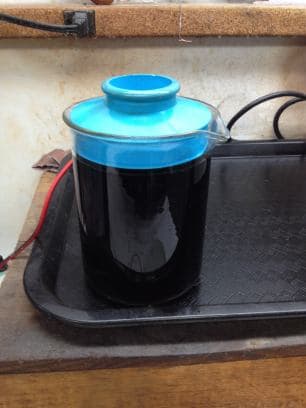
-----
Rhodium Plating Problems
Q. I have a problem with my new rhodium solution, I followed all the directions in replacing the old solution i.e. cleaning,distilled water new anode and silver wires. However I have a problem with the plated item coming out grey. I thought the rhodium was contaminated and filtered it through activated charcoal, but I'm still getting grey plating. I've done everything by the book. Could it be that my solution is too strong? What else can I do?
Manny Stergioumanufacturing jeweller - South Africa
November 24, 2009
|
|
A. Manny, Fellow Plater - Syracuse, NY USA A. This article may help you. www.ganokin.com/borisat/nenam/ajm-rhodium-plating-technique.htm Neil BellAlbuquerque, New Mexico A. Manny,Hi. - Penang, Malaysia A. PROBABLY YOUR CONCENTRATION IS HIGH Bnei Berak, Israel |
Q. I am trying to rhodium plate white gold. I am getting good plating in some sections and dull gray areas in other sections. It appears to be unrelated to the characteristics of the areas (easy to clean areas are gray, hard to clean areas are shiny - after plating). I've had this problem before, and resolved it by steaming the pieces after each cleaning bath, but now it has resurfaced. I just changed the ultrasonic and electroclean solutions, as they appeared dirty. The new solutions are the same strength. Any advice as to what can cause this "graying".
Jim Roselle- Pelham, New York
2001
A. Since the hard to clean areas are plating bright and these are probably also low current density areas I believe you either have your current too high or you are not agitating your part enough or both. In plater's lingo you are "burning" the part.
Neil BellAlbuquerque, New Mexico
2001
Q. The rhodium solution is turning black recently. Why? Are the anodes bad? Thank you in advance.

Eric Fenstermacher
- Dallas, Texas, USA
February 28, 2013
A. Hi Eric. Are you plating onto white gold, silver, a nickel underlayer or what? Please introduce yourself and your situation as we don't know if you are a beginner working with your first bowl of rhodium plating solution, or a process engineer with decades of experience running an industrial plating operation.
If you are new to this, my first suspicion would simply be that you've run out of rhodium. There is only 1 gram of rhodium in a typical half liter of solution. The anodes are not the source of the rhodium, they are platinized titanium insoluble anodes. Good luck.
Regards,

Ted Mooney, P.E.
Striving to live Aloha
finishing.com - Pine Beach, New Jersey
Ted is available for instant help
or longer-term assistance.
March 1, 2013
March 5, 2013
Q. Rhodium plating. Golds and platinum. In the past 4 months this has been happening. Solution turning black, but still works.

Constants: same rhodium solution supplier for over ten years
Same anode for about 3 years.
Same users
Same connectors
Same temperature
Same voltage and current
Same time limit on dipping.
Previous baths gave gotten weaker through high usage but it begins to lose the color not turning black as it does now. Could the supplier have changed the chemical makeup of their solution? Us the platinum titanium anode bad? Thank you for your help Ted

Eric Fenstermacher
Jeweler - Garland Texas
A. Hi. Thanks for the graphic. Now I see that I misread your inquiry and you meant the solution itself is turning black. Hopefully someone else will have a clue. That pitcher is glass, not plastic? And it's what you always store it in?
Regards,

Ted Mooney, P.E.
Striving to live Aloha
finishing.com - Pine Beach, New Jersey
Ted is available for instant help
or longer-term assistance.
March 5, 2013
Q. 600 mL Pyrex beaker [beakers on eBay or Amazon [affil link] . Yes we store it there. I am puzzled and the only variables are the maker of the solution and possible degrading of equipment and/or connectors/anodes. It still works! Crazy, but the color just doesn't seem right.

Eric Fenstermacher
- Garland Texas
March 5, 2013
A. Platinum plating baths will start out yellow and turn black. We believed the platinum ions are reduced in solution as another species is oxidized. The solution turns black as solid platinum metal colloids are formed.
I have limited experience with rhodium plating solutions and I would think a similar model is possible. The bath stability would depend on the choice of complexing agent (sulfamate or something else) and possibly the pH.
If the bath could be analyzed for rhodium concentration, pH, other metal ion impurities, and other components (if possible) this might help shed some light on the likely cause.
Hope this helps.
- Seattle, Washington, USA
April 4, 2013
![]() Rhodium solution turning black: it was the anode in the solution. It was old. I told them to check all of that stuff. Your answers to my questions helped Very much. Thank you very much. Now I have some diamonds to set!
Rhodium solution turning black: it was the anode in the solution. It was old. I told them to check all of that stuff. Your answers to my questions helped Very much. Thank you very much. Now I have some diamonds to set!

Eric Fenstermacher
- Dallas, Texas, USA
April 9, 2013
Q, A, or Comment on THIS thread -or- Start a NEW Thread